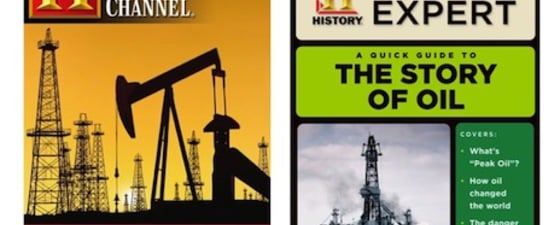Given the myriad role that oil and gas play in our daily life, society and industries, the importance of public education about the science, technology, and history of petroleum should be obvious. Documentary films are an important medium that shape public perceptions and knowledge about the oil and gas industry. I have watched a large number of these oil-related documentaries produced in recent years; here is a brief report.
Shortly after Daniel Yergin published his Pulitzer-winning book The Prize: The Epic Quest for Oil, Money and Power (1991), it was made into an eight-part series which was aired on PBS in the USA. This documentary (available in 4 video tapes, running 480 minutes) still remains our major audiovisual source on the history of oil in the 20th century with a focus on international politics.
The History Channel has produced three outstanding documentaries. Black Gold: The Story of Oil (1998 and 2005, 50 min.) portrays a sweeping history of oil and its impact on our world; Instant Expert: A Quick Guide to the Story of Oil (2010, 94 min.) is more educational on the science of oil and comes with a quiz at the end; Oil Rigs (2011, 47 min.) focuses on the design and operation of offshore oil rigs and platforms in the Gulf of Mexico.
Of the Discovery Channel’s Extreme Engineering series (hosted by Danny Forster), two episodes (50 min. each) are noteworthy here: Offshore Oil Platforms (2003) and Sakhalin Oil and Ice (2006).
Extreme Oil, produced in 2004 by Films for the Humanities and Science, comes in three parts (each 57 min.): ‘The Wilderness’ features the environmental impact and politics of oil production in Alaska’s Arctic National Wildlife Refuge (ANWAR); ‘The Oil Curse’ contrasts Texaco’s toxic environmental legacy in Ecuador with the prosperity that oil has brought to Angola; and ‘The Pipeline’ discusses the ambitious project of building a 1,100-mile pipeline from Baku on the Caspian Sea as far as Turkey’s Mediterranean port of Ceyhan.
Most of the documentaries highlight the adverse international, ‘peak-oil’ (no ‘cheap oil’) ‘oil addiction’ and environmental impacts of the oil industry, and hence promote the development of alternative energy sources. Notable among these are: The End of Suburbia: Oil Depletion and the Collapse of the American Dream (2004, 78 min.), Crude Impact (2006, 97 min.), Who Killed the Electric Car? (2006, 92 min.), A Crude Awakening: The Oil Crash (2007, 85 min.), Fuel (2010, 112 min.), and Gas Hole (2011, 100 min.).
Some documentaries deal with more focused, hot topics. The Oil Factor (2004, 93 min.), comments on the recent wars in the Middle East, while Blood and Oil: The Middle East in World War I (2006, 112 min.) takes us back to the very beginning of this issue. The award-winning Oil on Ice (2005, 58 min.) discusses ANWAR’s oil development; Crude (2009, 105 min.) is a look at the infamous Texaco case in Amazonian Ecuador; while H2Oil (2009, 76 min.) and the award-winning Petropolis (2010, 70 min.), both films by Canadian directors, explore the environmental hazards of developing the Athabasca oil sands (the size of England) in Alberta. Gasland (2010, 107 min.) discusses the environmental effects of hydraulic fracturing in the development of shale gas fields.
Last but not least, I should mention a documentary film that takes us back to the beginning of the oil industry in Pennsylvania in 1859. The Valley That Changed the World (produced by WQED, 2009, 57 min.) was released on the 150th anniversary of the Drake Well which changed the world. Here is a final point to contemplate: in 1859, when Edwin Drake drilled that successful well near Titusville, it was indeed a pioneer venture that proved timely, but no one in those days could imagine the industrial and digital technologies we now have access to – including the film industry.
The above documentaries are all available on DVD for purchase in online stores.





